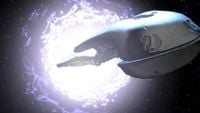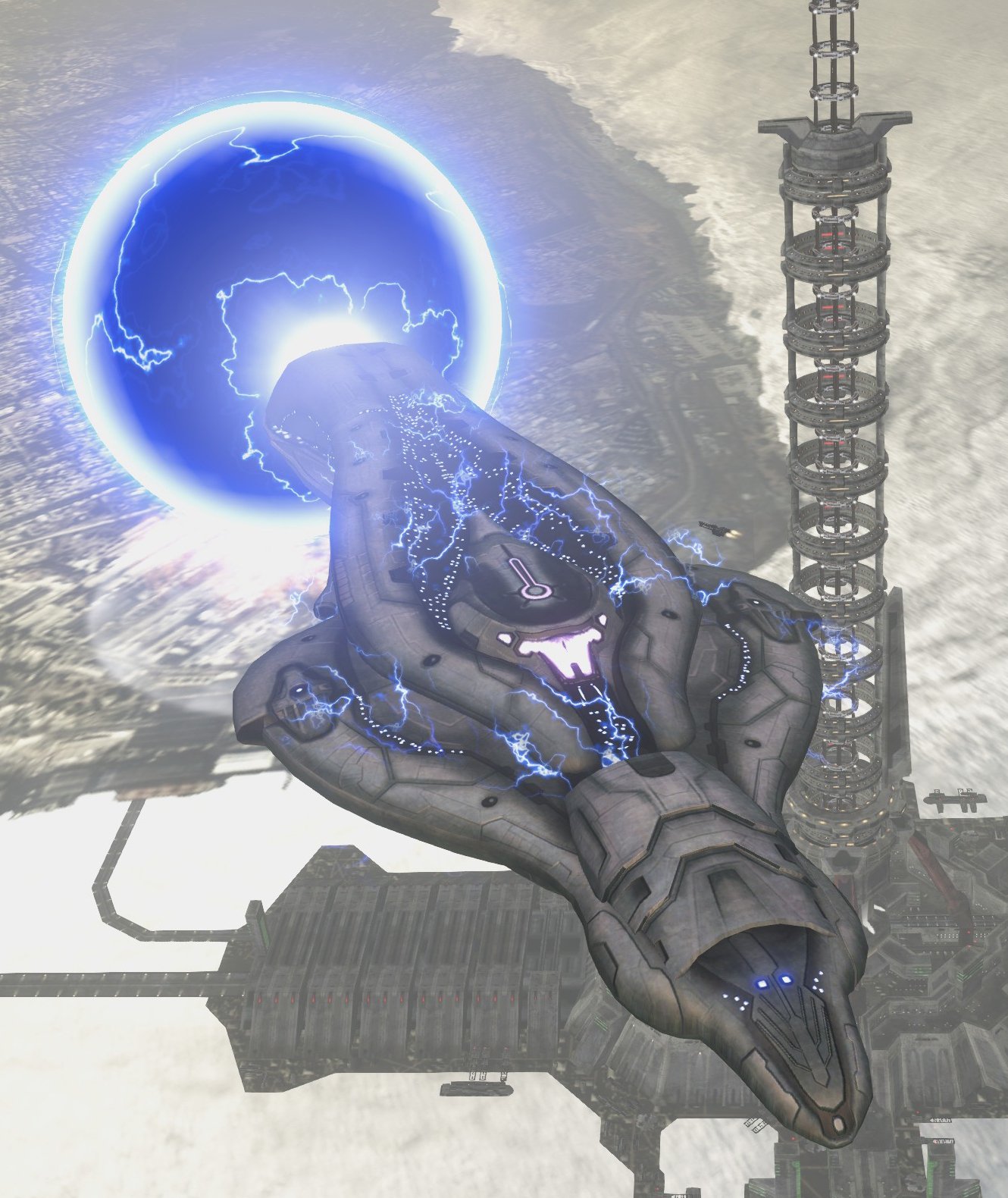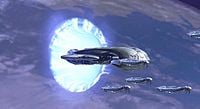Slipstream space
From Halopedia, the Halo wiki

Slipstream space (Slipspace for short), otherwise known as Shaw-Fujikawa space or subspace by the United Nations Space Command or simply the void to the Covenant, is a collective term for the seven non-visible infinitesimal quantum dimensions used for faster-than-light travel. Making a transition from one place to another via slipspace is known as a "slip", or "jump".
Background
Slipspace travel has been the UNSC's main way of traveling from planet to planet, and star-system to star-system since its discovery in 2291. Before this technology was discovered by Tobias Shaw and Wallace Fujikawa, mankind was never able to leave their home star system due to the constraints of relativistic theory, preventing faster than light travel. Now the UNSC traverses the galaxy in spacecraft to whole new worlds. The Slipspace drive is considered the most important invention in all of human history.
Mechanics
Slipspace is a tangle of intertwined dimensions, comparably similar to a wadded up piece of paper, which lie underneath the three conventional spatial dimensions of the universe. Because of this tangle of intertwined dimensions, objects in slipspace often group together in mass transit.
The Shaw-Fujikawa Translight Engine allowed human ships to tunnel into the Slipstream, Slipspace, technically called "Shaw-Fujikawa Space,"[1] after the scientists who proved its existence. Slipspace is a domain with alternate physical laws, allowing faster-than-light travel without relativistic side-effects i.e., the occupants do not "warp" time, despite their super-luminal speed. But however fast it may appear, faster-than-light travel is by no means instantaneous; "short" jumps routinely take up to two months, and "long" jumps can last six months or more; despite going faster than light, there is still a slight degree of Time Dilation, while a jump may last only a day or two, several weeks may have passed in real time, which is why most UNSC ships have cryo chambers, allowing their occupants to forestall the effects of aging, and minimize the need for crew supplies and quarters.
Slipspace can be thought of as our detectable universe (which, technically, it is) but with a greater number of dimensions. Our plane of existence is thought to have four dimensions (up-down, front-back, side-to-side and time), but Slipspace is an eleven-dimensional spacetime.[2] Slipspace is currently theorized (in 2552) as a "tangle" of our plane's dimensions, rather like taking the classic "flat sheet" used to represent gravity and crumpling it up into a ball, thereby creating extra dimensions and shorter spaces between points. The slipstream also possesses different laws of physics than our "normal" universe, although some basic ones, such as energy transfer and momentum, remain the same.[3]
The SFTE (Shaw-Fujikawa Translight Engine) generates a resonance field, which when coupled with the unusual physics of the Slipstream, allows for dramatically shorter transit times between stars; however, scientists note an odd "flexibility" to temporal flow while inside the Slipstream. Though no Human scientist is sure why travel time between stars is not constant, many theorize that there are "eddies" or "currents" within the Slipstream — there is generally a five to ten percent variance in travel times between stars. This temporal inconsistency has given military tacticians and strategists fits, hampering an uncounted number of coordinated attacks. Shaw-Fujikawa engines allow ships to leave normal space and plow through Slipspace. Slipspace drives use particle accelerators to rip apart normal space-time by generating micro black holes. These holes are evaporated via Hawking radiation in a nanosecond. The real quantum mechanical "magic" of the drive lies in how it manipulates these holes in space-time, squeezing vessels weighing thousands of tons into Slipspace.[4]
The Covenant have a very finely tuned version of this technology, far superior to the UNSC Shaw-Fujikawa Slipspace Drive. Instead of simply tearing a hole into Slipspace, Covenant Slipspace drives cut a very fine hole in the fabric of space-time and slips into Slipspace with precision (much like a scalpel compared to a butcher knife). It exits with the same pinpoint accuracy, takes less time during travel, and is able to plot a course with error not exceeding an atom. This is why in battle Covenant ships are able to slip by human defenses by using slipspace.[5]
Gravitational fields of significant size, such as those generated by a planet, affect the superfine quantum filaments that the Shaw-Fujikawa Translight Engine must use to calculate an entry point to the slipstream, and UNSC calculations are unable to offset this effect.[6] Covenant drives, in turn derived from Forerunner technology, have a much higher resolution of the filaments, and use more accurate calculations, and though the Covenant do not use this ability, are capable of making slipstream transition in and out of a planet's gravity well. Indeed, while using the captured Ascendant Justice to make a Slipspace jump within Threshold's atmosphere, Cortana remarked that "It was as if she was blind before."[6] After observing this innovation, a Covenant AI managed to leak the data out to the rest of the Covenant in a transmission. During the First Battle of Earth, the Prophet of Regret uses this newfound knowledge to transition into Slipspace while directly over New Mombasa in Earth's gravity well, devastating the city and causing the collapse of the Orbital Elevator there.[7] These events are further proof that the Covenant are imitative rather than innovative.
Slipspace travel is dangerous due to the high level of radiation encountered during the trip, which can be extremely hazardous to the crew. This is negated by the use of Lead Foil in UNSC ships, which absorbs the radiation. Fissile materials also emit radiation (specifically Cherenkov radiation, emitted when particles travel through a medium at a faster rate than light travels in that same medium. Named after the Russian physicist Pavel Alekseyevich Cherenkov) upon exiting Slipspace; this is not harmful to Humans, however it does make emerging from Slipspace very noticeable. It is not known how the Covenant deal with radiation, but it is presumed that either they also utilize lead, or with their improved Slipspace technology and Energy shields, it does not affect them at all.[8] During the beginning of the Civil War of the Covenant a Flood-controlled In Amber Clad entered slipspace and exited inside the dome of High Charity.[9]
The concept of using an alternate dimension with different laws to travel faster than general relativity allows was first posited as the Minkowski Space Theory.
Velocities
Human Slipspace drives are far slower than Covenant versions, only able to carry a ship at a speed of 2.625 light years per day [10], while Covenant drives can reach 912 light years per day[11], a vastly superior rate to UNSC Slipspace technology. The capture of a Covenant Slipspace drive by the Master Chief and survivors of the Battle of Reach and survivors of the events at Halo may have increased the capabilities of these Human Slipspace technologies.
One example of the differences between speeds is comparing the Covenant cruiser "Ascendant Justice" with the UNSC Halcyon-class cruiser "The Pillar of Autumn." It took several weeks for the Pillar of Autumn to get from Reach to Installation 04, yet the Ascendant Justice could get from Installation 04 to Reach within thirteen hours.
It should be noted that the Forerunner may have been able to achieve instantaneous travel through Slipspace, as the portal generated slipstream space that allowed the fleet to travel through to the Ark in an instant. This may require a huge amount of energy as the keyship was needed to activate the portal.
Dangers

Because the Slipstream is constantly shifting, and its laws of physics are different to our own, the magnetic coils of Slipspace drives drift out of phase when entering and leaving a Slipspace field, requiring constant maintenance. During the 2490's, technicians had to manually repair Slipspace drives, exposing themselves to the Slipstream and occasionally suffering injury, death or simply disappearing.[12]
In addition, Cherenkov radiation is emitted by fissile materials, including a ship's reactor and nuclear armaments, upon entry and exit of the dimension, requiring all Slipspace-capable craft to be fitted with lead shielding as radiation protection. Slipspace drives can only be equipped on large ships, as the stress that the constantly fluctuating Slipstream exerts is considerable and can tear a small craft, such as a dropship or star fighter, completely asunder.[13]
Direct exposure to the Slipstream is incredibly dangerous. People traveling on a Slipspace-capable craft can experience a range of symptoms, from nausea, to heart failure or even death. Even more uncommon, but still known to happen, is the total disappearance of a person while in the slipstream.[14] In some cases having a Forerunner object may cause the ship to be in the 'middle' of Slipspace.
Prior to 2552, entering slipspace from the gravity well of a planet had never been attempted, either by the UNSC or the Covenant. The effect of gravity upon the creation of a slipspace entrance usually collapsed UNSC-generated holes, and was assumed to be the same with Covenant technology. The flagship Ascendant Justice, however, was able to escape from a gas giant's gravity well after Cortana realized that it had a far higher resolution of the quantum filaments that allowed a transition, and she was able to compensate for the gravity. Subsequently, the ability was transmitted by a Covenant AI, and the Prophet of Regret used an in-atmosphere slipspace jump to escape Earth, with the resulting shockwave dealing devastating damage to the city of New Mombasa.
Entering and exiting the slipstream is normally only attempted by ships of large mass, their gravity wells stabilising slipspace to a degree that allows safe passage. Small ships, such as dropships, do not possess the same gravity and are placed under considerably more stress than a warship, able to crack the hull and buckle reinforcing struts.[15] It is not impossible, and UNSC slipstream monitoring probes make the transitions all the time, but require heavy reinforcement to survive the stresses, and are unmanned, having no need to protect internal occupants.[16] Small objects like ODST SOEIV pods can be modified to make the transition, but are still an extremely uncomfortable ride.[17]
Communications
The Forerunners were somehow capable of advanced message carrier waves in slipspace. This way, messages and memorandums could travel at great speeds throughout the Forerunner empire. Cortana was able to use this technology to declare codes Bandersnatch and Hydra during The First Battle of Earth and The Battle of Installation 05 in close-knitted timing and symmetry.
The closest technology the UNSC has been able to create like this is the Slipspace COM Launcher. Even then this technology is limited as there were only three in existence before 2552: one on Reach, one on Onyx and one on Earth. As of the conclusion of the Human-Covenant War, both the devices on Reach and Onyx have been destroyed, with the fate of the Earth device unknown. Because all communications can take years or decades to travel the lightyears between colonized star systems, UNSC civilians use Slipstream packets.[18][19] They use the slipstream to travel and to send communication signals significantly faster than otherwise possible, allowing faster communication between colonies.
Similarities
Slipspace can be likened and very familiar to the recent discovery of matterwave transport without transit. In this process the 7 hidden spatial dimensions, 3 known spatial dimensions and the 2 time dimensions appear to collapse into a singularity to an outside observer. But in reality, this is only an illusion. In this type of field, relativity predominates, for instance the reality is dependent on the radial displacement from the source that generates the field. At small distances, reality is relatively intact. The further away from the field source, the less sense it makes to talk about reality; a cause can occur after an effect, time has no linear flow. Nothing has a definite momentum or velocity. Objects can occur at multiple positions simultaneously. When an object enters a field, it produces a burst of neutrinos, antimatter and other types of radiation.
Trivia
- Slipspace fills a common niche found in most space science fiction series/films, allowing ships to travel vast distances in a small amount of time, allowing convenient travel through the galaxy. Though other series use different methods, it is most similar to hyperdrives, which similarly burrow into other (albeit more stable) dimensions where faster than light travel without the relativistic side effects is possible. Other series use different methods, allowing actual FTL travel in normal space, or instantaneous teleportation, but the principles still follow a similar trend.
- When a ship encounters a "Slipspace wake", they will be pushed to the speed the ship made. The UNSC Dusk took 2 weeks to get to Installation 05 via the Prophet of Regret's Assault Carrier's weakening "wake", but came back to Earth within hours by following the Forerunner Dreadnought's wake.
- Because all communications can take years or decades to travel the light years between colonized star systems, UNSC civilians use Slipstream packets. They use the Slipstream to travel and to send communication signals significantly faster than otherwise possible, allowing faster communication between the UNSC colonies.
- Nicole-458 was sent back in time, because of a Slipspace accident. Similarly, it also caused a UNSC AI to be transported from the year 2552 to the year 2004. This is because it is presumed that Slipstream travels at the speed of light, and according to Einstein's equation, the speed of light is equal to time travel.
- A Slipspace-to-normal space transition has been successfully attempted by a Spirit dropship, but it had been extensively equipped with Titanium-A battleplates, lead, and carbon-molybdenum steel I-beams.
- In Amber Clad made a precision jump into High Charity yet UNSC ships are normally not capable of precision jumps. This may be due to an improvement on the ship, the Gravemind adjusting it or possibly a whole lot of luck.
- The Forerunner Crystal found on Reach was capable of creating a distortion in Slipspace, but it also made massive amounts of radiation.
It has been also mentioned in Ghosts of Onyx that the SPARTAN III's were dropped onto the Covenant controlled planet from Slipspace, most likely suggesting that these drop pods were either developed on a large scale or reinforced specifically for that mission.
- it is similar to hyperspace from star wars
- ^ Halo: The Fall of Reach, page 141
- ^ Halo: First Strike
- ^ Halo: Ghosts of Onyx, pg 55
- ^ Halo: Ghosts of Onyx, page 53
- ^ Halo: First Strike, page 86
- ^ a b Halo: First Strike, page 85
- ^ Halo 2, level Metropolis (Level)
- ^ Halo: Ghosts of Onyx, page 13
- ^ Halo 2, level Gravemind (Level)
- ^ Velocity=Distance/time (V=10.5 light years/4 days=2.625 l/d)
- ^ Velocity=Distance/time (V=38 light years/1 hour=38 l/h or 912 l/d)
- ^ Halo: Ghosts of Onyx, page 146
- ^ Halo: First Strike, page 289
- ^ Halo: Contact Harvest, page 175
- ^ Halo: First Strike
- ^ Halo: The Fall of Reach
- ^ Halo: Ghosts of Onyx
- ^ http://transmit.ilovebees.com/surveillance_archive/week6_subject3.wav
- ^ Axon Clips Chapter 6#Kamal
